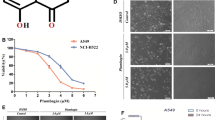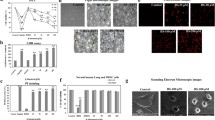Abstract
α-Mangostin (MAN) is a bioactive compound isolated from the inedible pericarp of a tropical fruit mangosteen (Garcinia mangostana Linn). It exhibits notable therapeutic potentials on lung cancers, but the underlying mechanisms are still largely unknown. This study was designed to further explore the mechanisms involved in cytotoxicity of MAN on A549 cells. Apoptosis and cell cycle distribution were analyzed by flow cytometry methods. The fluorescent probes DCFH-DA and JC-1 were used to assess the intracellular reactive oxidative species (ROS) and mitochondrial membrane potential statuses, respectively. The regulation of MAN on relevant pathways was investigated by immunoblotting assays. The results obtained indicated that MAN caused significant apoptosis and cell cycle arrest in A549 cells, which eventually resulted in inhibition on cell proliferation in vitro. All these phenomena were synchronized with escalated oxidative stress and downregulation of nicotinamide phosphoribosyltransferase/nicotinamide adenine dinucleotide (NAMPT/NAD). Supplementation with nicotinamide mononucleotide (NMN) and N-acetylcysteine (NAC) efficiently eased MAN-induced ROS accumulation, and potently antagonized MAN-elicited apoptosis and cell cycle arrest. The pro-apoptotic effect of MAN was further confirmed by increased expressions of cleaved caspase 3, 6, 7, and 9, and its effect on cell cycle progression was validated by the altered expressions of p-p38, p-p53, CDK4, and cyclin D1. The immunoblotting assays also demonstrated that NAC/NMN effectively restored these molecular changes elicited by MAN treatment. Collectively, this study revealed a unique anti-tumor mechanism of MAN by provoking ROS production through downregulation of NAMPT/NAD signaling and further validated MAN as a potential therapeutic reagent for lung cancer treatment.




Similar content being viewed by others
References
Abdallah HM, El-Bassossy H, Mohamed GA, El-Halawany AM, Alshali KZ, Banjar ZM (2016) Phenolics from Garcinia mangostana alleviate exaggerated vasoconstriction in metabolic syndrome through direct vasodilatation and nitric oxide generation. BMC Complement Altern Med 16:359
Akao Y, Nakagawa Y, Nozawa Y (2008) Anti-cancer effects of xanthones from pericarps of mangosteen. Int J Mol Sci 9:355–370
Asif J, Sahabjada S, Amar D, Md A (2018) Induction of apoptosis by alpha-mangostin in human hepatocellular carcinoma cells via nuclear fragmentation and ROS dependent mitochondrial pathway. J Clin Exp Hepatol 8:S116
Bi TQ, Che XM (2010) Nampt/PBEF/visfatin and cancer. Cancer Biol Ther 10:119–125
Bułdak RJ, Bułdak L, Polaniak R, Kukla M, Birkner E, Kubina R, Kabała-Dzik A, Duława-Bułdak A, Żwirska-Korczala K (2013) Visfatin affects redox adaptative responses and proliferation in Me45 human malignant melanoma cells: an in vitro study. Oncol Rep 29:771–778
Cerna D, Li H, Flaherty S, Takebe N, Coleman CN, Yoo SS (2012) Inhibition of nicotinamide phosphoribosyltransferase (NAMPT) activity by small molecule GMX1778 regulates reactive oxygen species (ROS)-mediated cytotoxicity in a p53- and nicotinic acid phosphoribosyltransferase1 (NAPRT1)-dependent manner. J Biol Chem 87:22408–22417
Chen W, Zheng R, Zeng H, Zhang S (2015) Epidemiology of lung cancer in China. Thoracic Cancer 6:209–215
Cheng K, Zhang G, Qiu S, Liu Y, Wang Y, Liu S, Shan Y, Yu B, Lu Y (2014) Synthesis and antitumor activities of α-,γ-mangostin derivatives. Lett Drug Des Discov 11:586–593
Chitra S, Krithika MV, Pavithra S (2010) Induction of apoptosis by xanthones from Garcinia mangostana in human breast and laryngeal carcinoma cell lines. IJPBS 1:1–8
DeSantis CE, Siegel RL, Sauer AG, Miller KD, Fedewa SA, Alcaraz KI, Jemal A (2016) Cancer statistics for African Americans, 2016: progress and opportunities in reducing racial disparities. Cancer J Clin 66:290–308
Ferlay J, Soerjomataram I, Dikshit R, Eser S, Mathers C, Rebelo M, Parkin DM, Forman D, Bray F (2015) Cancer incidence and mortality worldwide: sources, methods and major patterns in GLOBOCAN 2012. Int J Cancer 136:E359–E386
Garten A, Petzold S, Körner A, Imai S, Kiess W (2009) Nampt: linking NAD biology, metabolism and cancer. Trends Endocrinol Metab 20:130–138
Genovese S, Fiorito S, Taddeo VA, Epifano F (2016) Recent developments in the pharmacology of prenylated xanthones. Drug Discov Today 21:1814–1819
Hafeez BB, Mustafa A, Fischer JW, Singh A, Zhong W, Shekhani MO, Meske L, Havighurst T, Kim K, Verma AK (2014) α-Mangostin: a dietary antioxidant derived from the pericarp of Garcinia mangostana L. inhibits pancreatic tumor growth in xenograft mouse model. Antioxid Redox Signal 21:682–699
Hirsch FR, Scagliotti GV, Mulshine JL, Kwon R, Curran WJ Jr, Wu YL, Paz-Ares L (2017) Lung cancer: current therapies and new targeted treatments. Lancet 389:299–311
Horita N, Nagashima A, Nakashima K, Shibata Y, Ito K, Goto A, Yamanaka T, Kaneko T (2017) The best platinum regimens for chemo-naive incurable non-small cell lung cancer: network meta-analysis. Sci Rep 7:13185
Johnson JJ, Petiwala SM, Syed DN, Rasmussen JT, Adhami VM, Siddiqui IA, Kohl AM, Mukhtar H (2012) α-Mangostin, a xanthone from mangosteen fruit, promotes cell cycle arrest in prostate cancer and decreases xenograft tumor growth. Carcinogenesis 33:413–419
Jung HA, Su BN, Keller WJ, Mehta RG, Kinghorn AD (2006) Antioxidant xanthones from the pericarp of Garcinia mangostana (mangosteen). J Agric Food Chem 54:2077–2082
Kwak HH, Kim IR, Kim HJ, Park BS, Yu SB (2016, 2016) α-Mangostin induces apoptosis and cell cycle arrest in oral squamous cell carcinoma cell. Evid Based Complement Alternat Med 5352412
Kurose H, Shibata MA, Iinuma M, Otsuki Y (2012) Alterations in cell cycle and induction of apoptotic cell death in breast cancer cells treated with α-mangostin extracted from mangosteen pericarp. J Biomed Biotechnol 2012:672428
Lee CH, Ying TH, Chiou HL, Hsieh SC, Wen SH, Chou RH, Hsieh YH (2017) Alpha-mangostin induces apoptosis through activation of reactive oxygen species and ASK1/p38 signaling pathway in cervical cancer cells. Oncotarget 8:47425–47439
Miller KD, Siegel RL, Lin CC, Mariotto AB, Kramer JL, Rowland JH, Yabroff KR, Alfano CM, Jemal A, Kramer JL, Siegel RL (2016) Cancer treatment and survivorship statistics, 2016. CA. Cancer J Clin 66:271–289
Mohamed GA, Al-Abd AM, El-Halawany AM, Abdallah HM, Ibrahim SRM (2017) New xanthones and cytotoxic constituents from Garcinia mangostana fruit hulls against human hepatocellular, breast, and colorectal cancer cell lines. J Ethnopharmacol 198:302–312
Mohamed GA, Ibrahim SRM, Shaaban MIA, Ross SA (2014) Mangostanaxanthones I and II, new xanthones from the pericarp of Garcinia mangostana. Fitoterapia 98:215–221
Ovalle-Magallanes B, Eugenio-Pérez D, Pedraza-Chaverri J (2017) Medicinal properties of mangosteen (Garcinia mangostana L.): a comprehensive update. Food Chem Toxicol 109:102–122
Pan B, Zhong W, Deng Z, Lai C, Chu J, Jiao G, Liu J, Zhou Q (2016) Inhibition of prostate cancer growth by solanine requires the suppression of cell cycle proteins and the activation of ROS/P38 signaling pathway. Cancer Med 5:3214–3222
Pedrazachaverri J, Cárdenasrodríguez N, Orozcoibarra M, Pérez-Rojas JM (2008) Medicinal properties of mangosteen (Garcinia mangostana). Food Chem Toxicol 46:3227–3239
Pedraza-Chaverrí J, Reyes-Fermín LM, Nolasco-Amaya EG, Orozco-Ibarra M, Medina-Campos ON, González-Cuahutencos O, Rivero-Cruz I, Mata R (2009) ROS scavenging capacity and neuroprotective effect of α-mangostin against 3-nitropropionic acid in cerebellar granule neurons. Exp Toxicol Pathol 61:491–501
Phan TKT, Shahbazzadeh F, Pham TTH, Kihara T (2018) Alpha-mangostin inhibits the migration and invasion of A549 lung cancer cells. PeerJ 6:e5027
Reck M, Popat S, Reinmuth N, De Ruysscher D, Kerr KM, Peters S (2014) Metastatic non-small-cell lung cancer (NSCLC): ESMO Clinical Practice Guidelines for diagnosis, treatment and follow-up. Ann Oncol 25: iii27–iii39,
Sánchez-Pérez Y, Morales-Bárcenas R, García-Cuellar CM, López-Marure R, Calderon-Oliver M, Pedraza-Chaverri J, Chirino YI (2010) The α-mangostin prevention on cisplatin-induced apoptotic death in LLC-PK1 cells is associated to an inhibition of ROS production and p53 induction. Chem Biol Interact 188:144–150
Shih YW, Chien ST, Chen PS, Lee JH, Wu SH, Yin LT (2010) α-Mangostin suppresses phorbol 12-myristate 13-acetate-induced MMP-2/MMP-9 expressions via αvβ3 integrin/FAK/ERK and NF-κB signaling pathway in human lung adenocarcinoma A549 cells. Cell Biochem Biophys 58:31–44
Siegel RL, Miller KD, Jemal A (2016) Cancer statistics, 2016. CA. Cancer J Clin 66:7–30
Tan B, Huang Y, Lan L, Zhang B, Ye L, Yan W, Wang F, Lin N (2019) Bruceine D induces apoptosis in human non-small cell lung cancer cells through regulating JNK pathway. Biomed Pharmacother 117:109089
Tao M, Jiang J, Wang L, Li Y, Mao Q, Dong J, Zuo J (2018) α-Mangostin alleviated lipopolysaccharide induced acute lung injury in rats by suppressing NAMPT/NAD controlled inflammatory reactions. Evid Based Complement Alternat Med 2018:5470187
Wang T, Nelson RA, Bogardus GFW Jr (2010) Five-year lung cancer survival. Which advanced stage non-small cell lung cancer patients attain long-term survival. Cancer 116:1518–1525
Wang L, Zhao D, Qin K, Rehman FUL, Zhang X (2019) Effect and biomarker of nivolumab for non–small-cell lung cancer. Biomed Pharmacother 117:109199
Watanapokasin R, Jarinthanan F, Jerusalmi A, Suksamrarn S, Nakamura Y, Sukseree S, Uthaisang-Tanethpongtamb W, Ratananukul P, Sano T (2010) Potential of xanthones from tropical fruit mangosteen as anti-cancer agents: caspase-dependent apoptosis induction in vitro and in mice. Appl Biochem Biotechnol 162:1080–1094
Wu XJ, Kassie F, Mersch-Sundermann V (2005) The role of reactive oxygen species (ROS) production on diallyl disulfide (DADS) induced apoptosis and cell cycle arrest in human A549 lung carcinoma cells. Mutat Res 579:115–124
Xue C, Hu Z, Jiang W, Zhao Y, Xu F, Huang Y, Zhao H, Wu J, Zhang Y, Zhao L, Zhang J, Chen L, Zhang L (2012) National survey of the medical treatment status for non-small cell lung cancer (NSCLC) in China. Lung Cancer 77:371–375
Yeung S (2006) Mangosteen for the cancer patient: facts and myths. J Soc Integr Oncol 4:130–134
Zhang C, Yu G, Shen Y (2018) The naturally occurring xanthone α-mangostin induces ROS-mediated cytotoxicity in non-small-scale lung cancer cells. Saudi J Biol Sci 25:1090–1095
Zuo J, Dou DY, Wang HF, Zhu YH, Li Y, Luan JJ (2017) Reactive oxygen species mediated NF-κB/p38 feedback loop implicated in proliferation inhibition of HFLS-RA cells induced by 1,7-dihydroxy-3,4-dimethoxyxanthone. Biomed Pharmacother 94:1002–1009
Funding
This work was supported by the National Natural Science Foundation of China (81603388), Talent Cultivation and International Academic Visiting Project for College Scholar of Anhui Province (gxfxZD2016163), Funding of “Peak” Training Program for Scientific Research of Yijishan Hospital, Wannan Medical College (GF2019J01), and Research Project on Traditional Chinese medicine of Anhui province (2016zy37).
Author information
Authors and Affiliations
Corresponding author
Ethics declarations
Conflict of interest
The authors declare that they have no conflict of interest.
Additional information
Publisher’s note
Springer Nature remains neutral with regard to jurisdictional claims in published maps and institutional affiliations.
Rights and permissions
About this article
Cite this article
Ding, YY., Luan, JJ., Fan, Y. et al. α-Mangostin reduced the viability of A594 cells in vitro by provoking ROS production through downregulation of NAMPT/NAD. Cell Stress and Chaperones 25, 163–172 (2020). https://doi.org/10.1007/s12192-019-01063-2
Received:
Revised:
Accepted:
Published:
Issue Date:
DOI: https://doi.org/10.1007/s12192-019-01063-2




